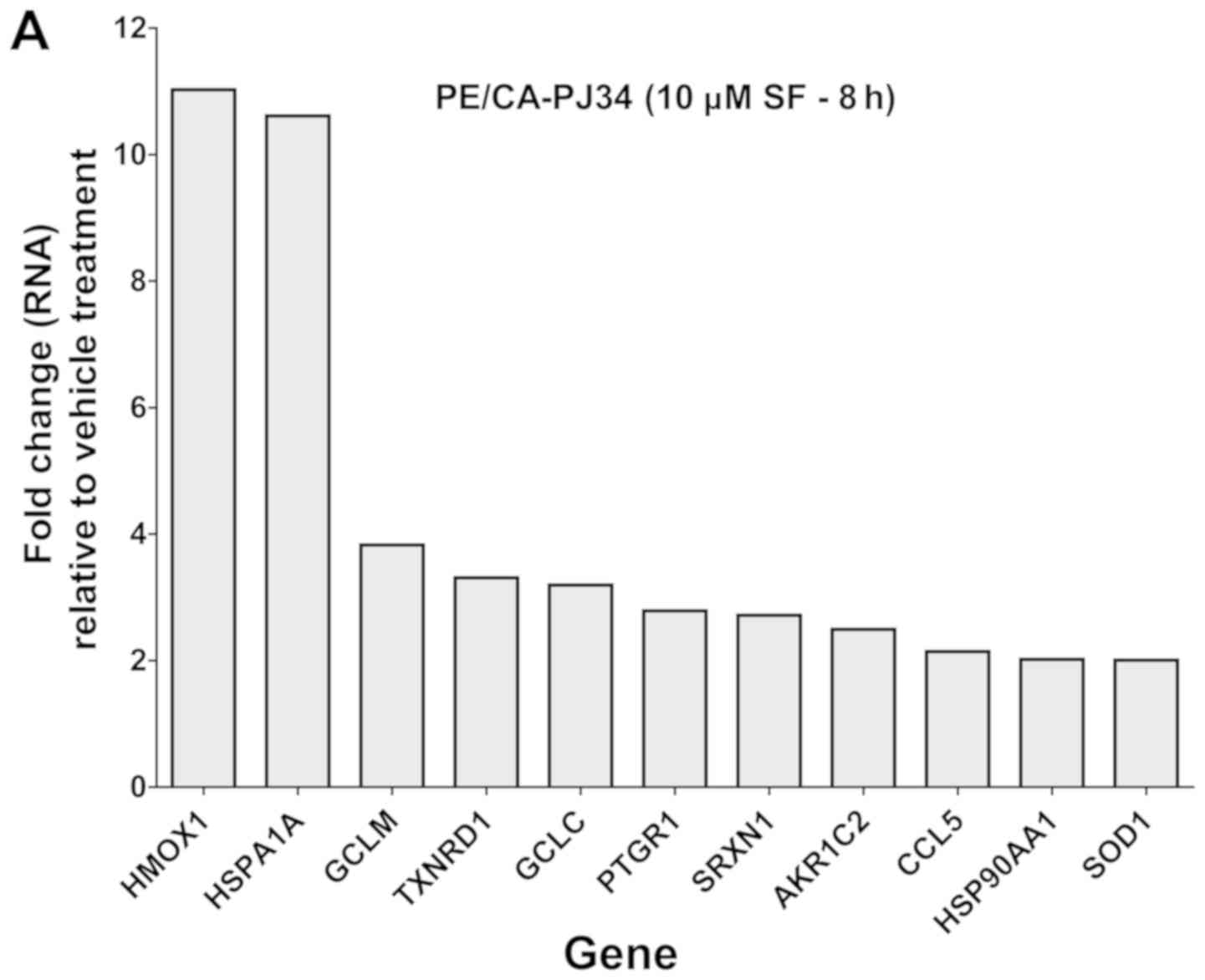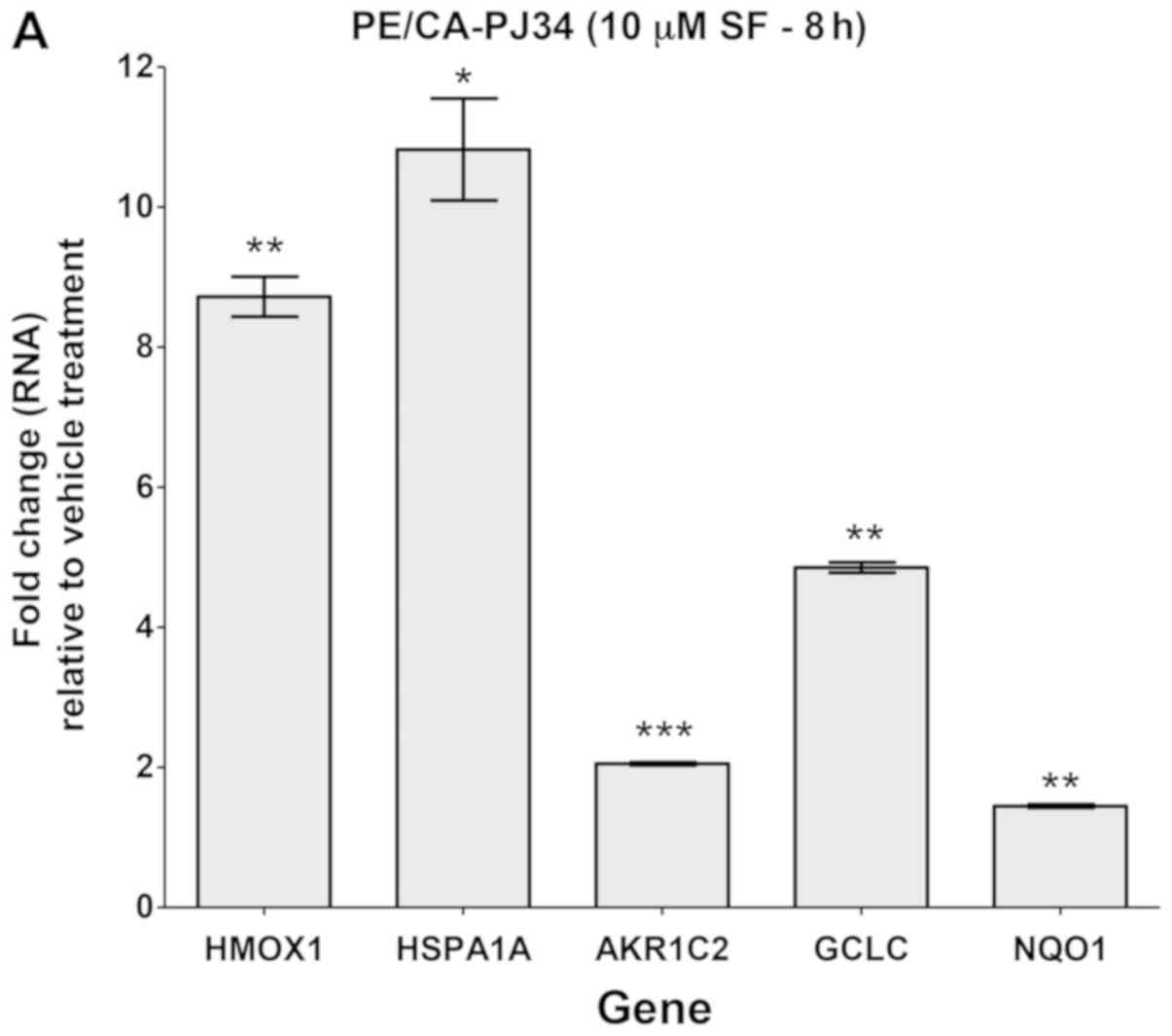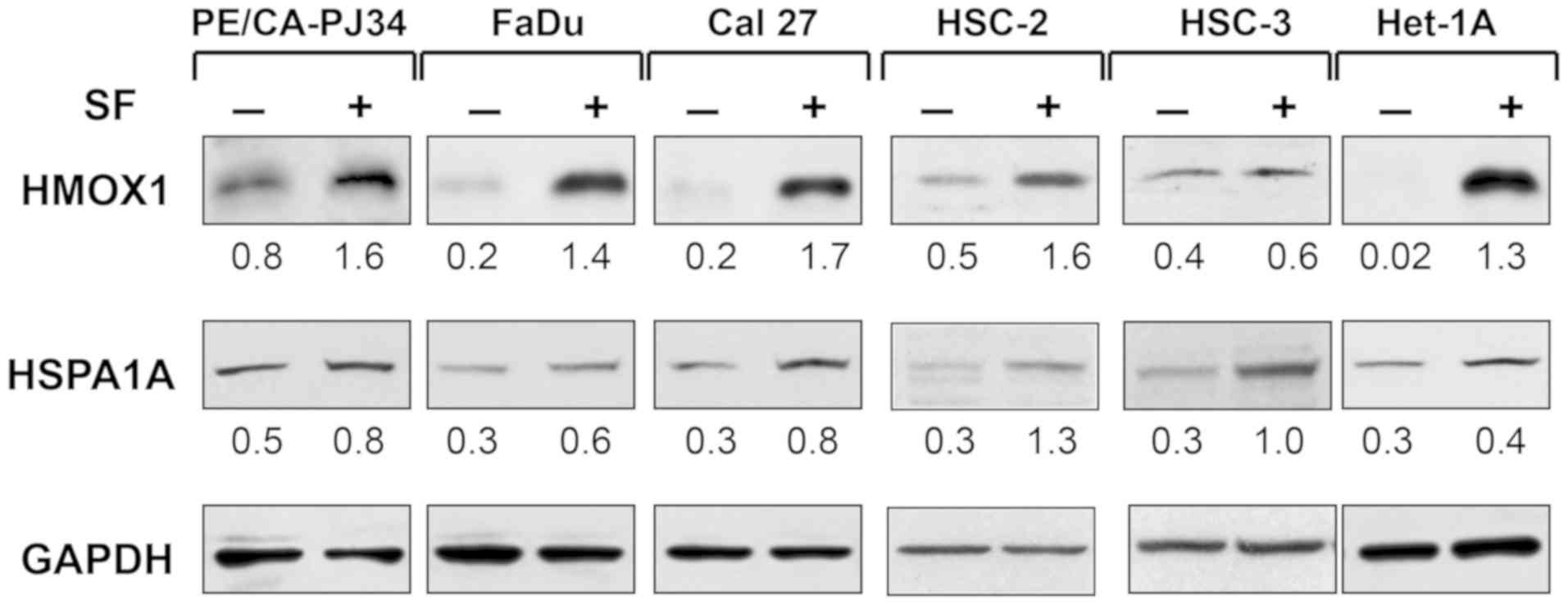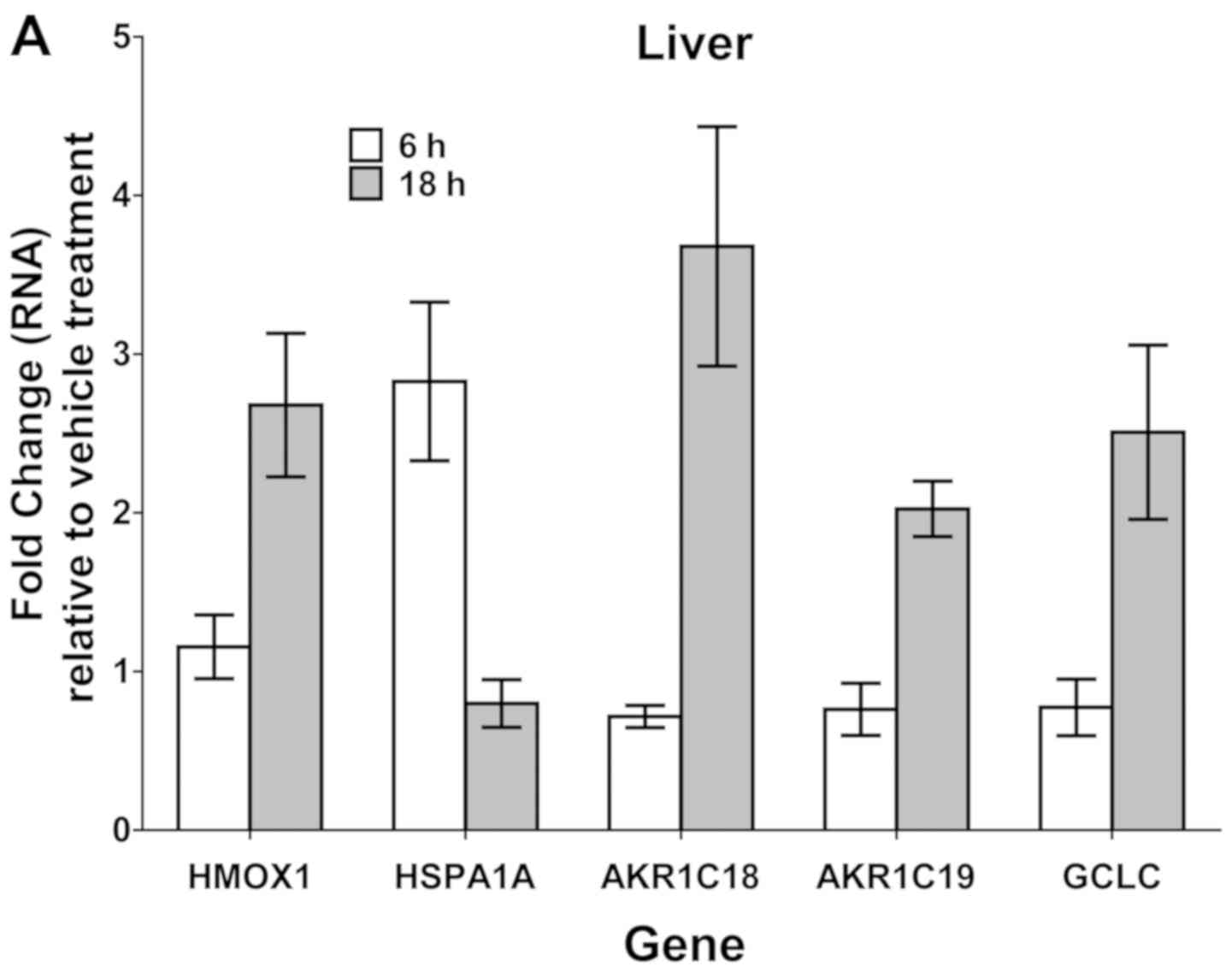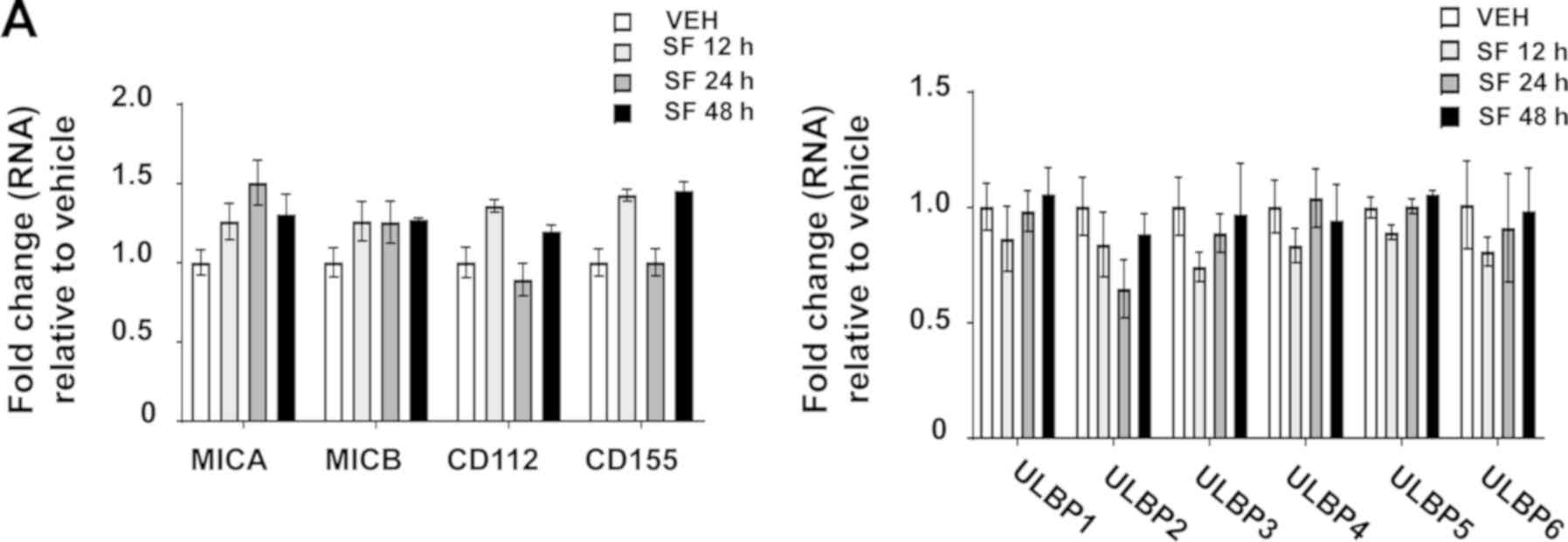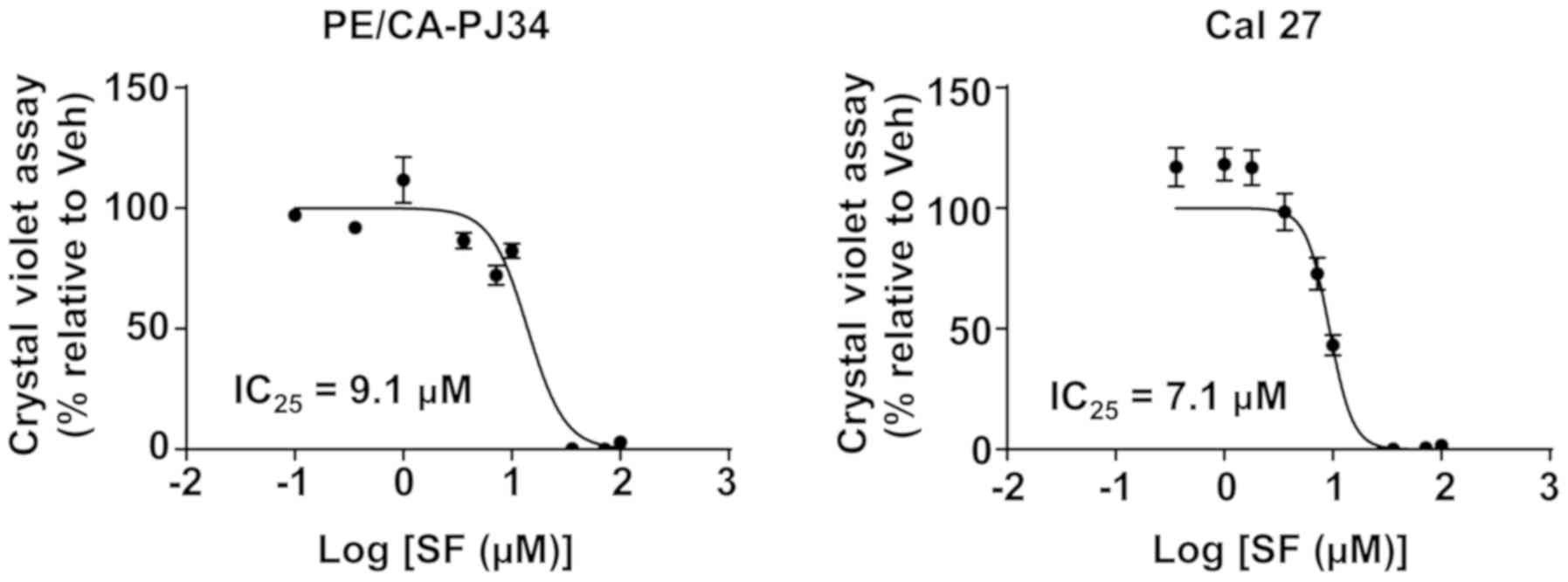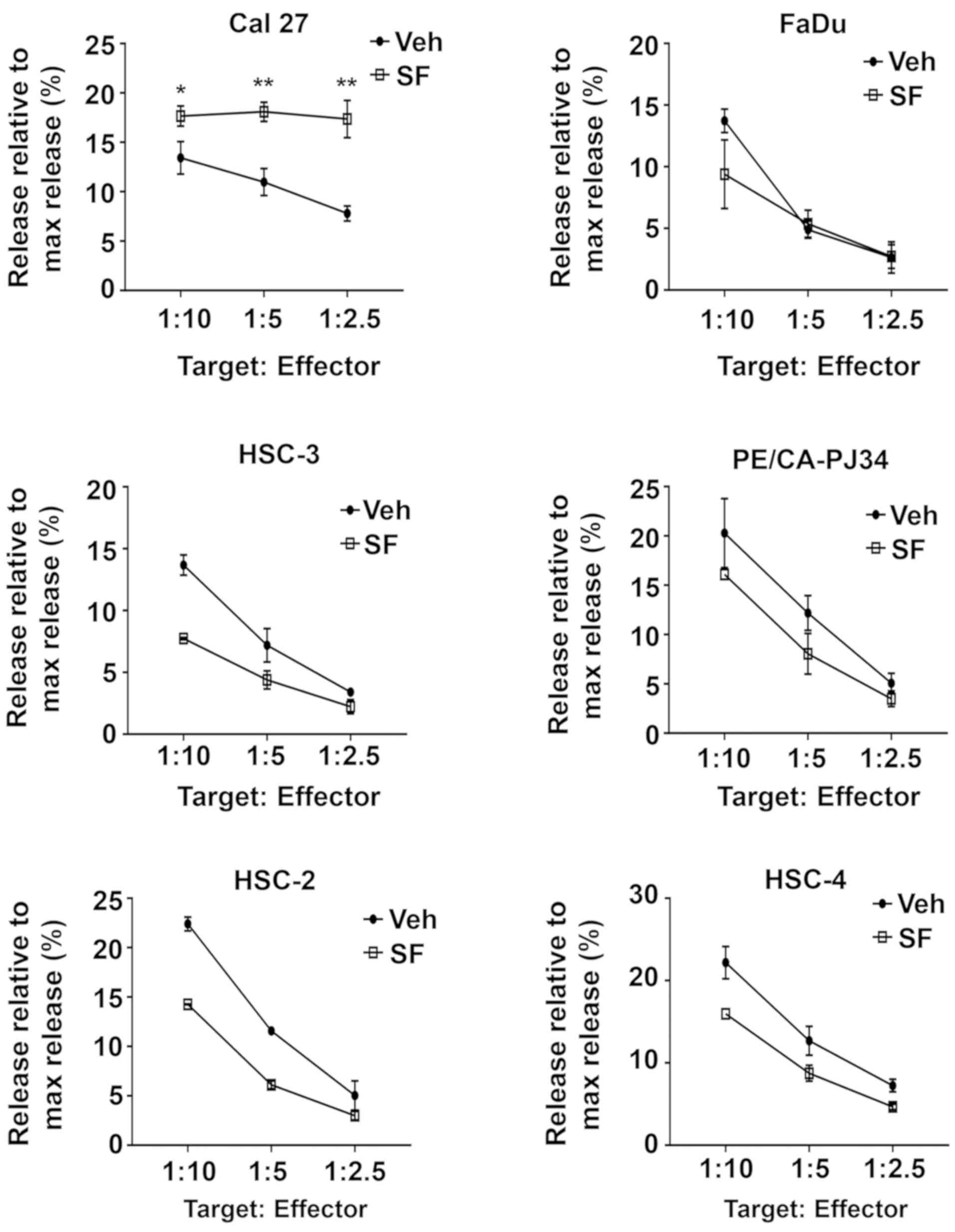|
1
|
Global Burden of Disease Cancer
Collaboration, ; Fitzmaurice C, Allen C, Barber RM, Barregard L,
Bhutta ZA, Brenner H, Dicker DJ, Chimed-Orchir O, Dandona R, et al:
Global, regional, and national cancer incidence, mortality, years
of life lost, years lived with disability, and disability-adjusted
life-years for 32 cancer groups, 1990 to 2015: A systematic
analysis for the global burden of disease study. JAMA Oncol.
3:524–458. 2017. View Article : Google Scholar : PubMed/NCBI
|
|
2
|
Siegel RL, Miller KD and Jemal A: Cancer
statistics, 2018. CA Cancer J Clin. 68:7–30. 2018. View Article : Google Scholar : PubMed/NCBI
|
|
3
|
Hashibe M, Brennan P, Chuang SC, Boccia S,
Castellsague X, Chen C, Curado MP, Dal Maso L, Daudt AW, Fabianova
E, et al: Interaction between tobacco and alcohol use and the risk
of head and neck cancer: Pooled analysis in the International Head
and Neck Cancer Epidemiology Consortium. Cancer Epidemiol
Biomarkers Prev. 18:541–550. 2009. View Article : Google Scholar : PubMed/NCBI
|
|
4
|
Gillison ML, Koch WM, Capone RB, Spafford
M, Westra WH, Wu L, Zahurak ML, Daniel RW, Viglione M, Symer DE, et
al: Evidence for a causal association between human papillomavirus
and a subset of head and neck cancers. J Natl Cancer Inst.
92:709–720. 2000. View Article : Google Scholar : PubMed/NCBI
|
|
5
|
Gillison ML, Chaturvedi AK, Anderson WF
and Fakhry C: Epidemiology of human papillomavirus-positive head
and neck squamous cell carcinoma. J Clin Oncol. 33:3235–3242. 2015.
View Article : Google Scholar : PubMed/NCBI
|
|
6
|
Bonner JA, Harari PM, Giralt J, Azarnia N,
Shin DM, Cohen RB, Jones CU, Sur R, Raben D, Jassem J, et al:
Radiotherapy plus cetuximab for squamous-cell carcinoma of the head
and neck. N Engl J Med. 354:567–578. 2006. View Article : Google Scholar : PubMed/NCBI
|
|
7
|
Vermorken JB, Mesia R, Rivera F, Remenar
E, Kawecki A, Rottey S, Erfan J, Zabolotnyy D, Kienzer HR, Cupissol
D, et al: Platinum-based chemotherapy plus cetuximab in head and
neck cancer. N Engl J Med. 359:1116–1127. 2008. View Article : Google Scholar : PubMed/NCBI
|
|
8
|
Seiwert TY, Burtness B, Mehra R, Weiss J,
Berger R, Eder JP, Heath K, McClanahan T, Lunceford J, Gause C, et
al: Safety and clinical activity of pembrolizumab for treatment of
recurrent or metastatic squamous cell carcinoma of the head and
neck (KEYNOTE-012): An open-label, multicentre, phase 1b trial.
Lancet Oncol. 17:956–965. 2016. View Article : Google Scholar : PubMed/NCBI
|
|
9
|
Chow LQ, Haddad R, Gupta S, Mahipal A,
Mehra R, Tahara M, Berger R, Eder JP, Burtness B, Lee SH, et al:
Antitumor activity of pembrolizumab in biomarker-unselected
patients with recurrent and/or metastatic head and neck squamous
cell carcinoma: Results from the phase Ib KEYNOTE-012 expansion
cohort. J Clin Oncol. 34:3838–3845. 2016. View Article : Google Scholar : PubMed/NCBI
|
|
10
|
Ferris RL, Blumenschein G Jr, Fayette J,
Guigay J, Colevas AD, Licitra L, Harrington K, Kasper S, Vokes EE,
Even C, et al: Nivolumab for recurrent squamous-cell carcinoma of
the head and neck. N Engl J Med. 375:1856–1867. 2016. View Article : Google Scholar : PubMed/NCBI
|
|
11
|
Lippman SM and Hong WK: Second malignant
tumors in head and neck squamous cell carcinoma: The overshadowing
threat for patients with early-stage disease. Int J Radiat Oncol
Biol Phys. 17:691–694. 1989. View Article : Google Scholar : PubMed/NCBI
|
|
12
|
Day GL, Blot WJ, Shore RE, McLaughlin JK,
Austin DF, Greenberg RS, Liff JM, Preston-Martin S, Sarkar S,
Schoenberg JB, et al: Second cancers following oral and pharyngeal
cancers: Role of tobacco and alcohol. J Natl Cancer Inst.
86:131–137. 1994. View Article : Google Scholar : PubMed/NCBI
|
|
13
|
León X, Quer M, Diez S, Orús C,
López-Pousa A and Burgués J: Second neoplasm in patients with head
and neck cancer. Head Neck. 21:204–210. 1999. View Article : Google Scholar : PubMed/NCBI
|
|
14
|
Lee DH, Roh JL, Baek S, Jung JH, Choi SH,
Nam SY and Kim SY: Second cancer incidence, risk factor, and
specific mortality in head and neck squamous cell carcinoma.
Otolaryngol Head Neck Surg. 149:579–586. 2013. View Article : Google Scholar : PubMed/NCBI
|
|
15
|
Sheth SH, Johnson DE, Kensler TW and
Bauman JE: Chemoprevention targets for tobacco-related head and
neck cancer: Past lessons and future directions. Oral Oncol.
51:557–564. 2015. View Article : Google Scholar : PubMed/NCBI
|
|
16
|
Slaughter DP, Southwick HW and Smejkal W:
Field cancerization in oral stratified squamous epithelium;
clinical implications of multicentric origin. Cancer. 6:963–968.
1953. View Article : Google Scholar : PubMed/NCBI
|
|
17
|
Hong WK, Endicott J, Itri LM, Doos W,
Batsakis JG, Bell R, Fofonoff S, Byers R, Atkinson EN, Vaughan C,
et al: 13-cis-retinoic acid in the treatment of oral leukoplakia. N
Engl J Med. 315:1501–1505. 1986. View Article : Google Scholar : PubMed/NCBI
|
|
18
|
Hong WK, Lippman SM, Itri LM, Karp DD, Lee
JS, Byers RM, Schantz SP, Kramer AM, Lotan R, Peters LJ, et al:
Prevention of second primary tumors with isotretinoin in
squamous-cell carcinoma of the head and neck. N Engl J Med.
323:795–801. 1990. View Article : Google Scholar : PubMed/NCBI
|
|
19
|
Khuri FR, Lee JJ, Lippman SM, Kim ES,
Cooper JS, Benner SE, Winn R, Pajak TF, Williams B, Shenouda G, et
al: Randomized phase III trial of low-dose isotretinoin for
prevention of second primary tumors in stage I and II head and neck
cancer patients. J Natl Cancer Inst. 98:441–450. 2006. View Article : Google Scholar : PubMed/NCBI
|
|
20
|
Leeman-Neill RJ, Seethala RR, Singh SV,
Freilino ML, Bednash JS, Thomas SM, Panahandeh MC, Gooding WE,
Joyce SC, Lingen MW, et al: Inhibition of EGFR-STAT3 signaling with
erlotinib prevents carcinogenesis in a chemically-induced mouse
model of oral squamous cell carcinoma. Cancer Prev Res (Phila).
4:230–237. 2011. View Article : Google Scholar : PubMed/NCBI
|
|
21
|
Gohagan JK, Prorok PC, Hayes RB and Kramer
BS; Prostate Lung, Colorectal and Ovarian Cancer Screening Trial
Project Team, : The prostate, lung, colorectal and ovarian (PLCO)
cancer screening trial of the national cancer institute: History,
organization, and status. Control Clin Trials. 21 (Suppl
6):251S–272S. 2000. View Article : Google Scholar : PubMed/NCBI
|
|
22
|
Mulshine JL, Atkinson JC, Greer RO,
Papadimitrakopoulou VA, Van Waes C, Rudy S, Martin JW, Steinberg
SM, Liewehr DJ, Avis I, et al: Randomized, double-blind,
placebo-controlled phase IIb trial of the cyclooxygenase inhibitor
ketorolac as an oral rinse in oropharyngeal leukoplakia. Clin
Cancer Res. 10:1565–1573. 2004. View Article : Google Scholar : PubMed/NCBI
|
|
23
|
Jayaprakash V, Rigual NR, Moysich KB,
Loree TR, Nasca MA, Menezes RJ and Reid ME: Chemoprevention of head
and neck cancer with aspirin: A case-control study. Arch
Otolaryngol Head Neck Surg. 132:1231–1236. 2006. View Article : Google Scholar : PubMed/NCBI
|
|
24
|
Papadimitrakopoulou VA, William WN Jr,
Dannenberg AJ, Lippman SM, Lee JJ, Ondrey FG, Peterson DE, Feng L,
Atwell A, El-Naggar AK, et al: Pilot randomized phase II study of
celecoxib in oral premalignant lesions. Clin Cancer Res.
14:2095–2101. 2008. View Article : Google Scholar : PubMed/NCBI
|
|
25
|
Ahmadi N, Goldman R, Seillier-Moiseiwitsch
F, Noone AM, Kosti O and Davidson BJ: Decreased risk of squamous
cell carcinoma of the head and neck in users of nonsteroidal
anti-inflammatory drugs. Int J Otolaryngol. 2010:4241612010.
View Article : Google Scholar : PubMed/NCBI
|
|
26
|
Wilson JC, Murray LJ, Hughes CM, Black A
and Anderson LA: Non-steroidal anti-inflammatory drug and aspirin
use and the risk of head and neck cancer. Br J Cancer.
108:1178–1181. 2013. View Article : Google Scholar : PubMed/NCBI
|
|
27
|
Saba NF, Hurwitz SJ, Kono SA, Yang CS,
Zhao Y, Chen Z, Sica G, Muller S, Moreno-Williams R, Lewis M, et
al: Chemoprevention of head and neck cancer with celecoxib and
erlotinib: Results of a phase ib and pharmacokinetic study. Cancer
Prev Res (Phila). 7:283–291. 2014. View Article : Google Scholar : PubMed/NCBI
|
|
28
|
Hedberg ML, Peyser ND, Bauman JE, Gooding
WE, Li H, Bhola NE, Zhu TR, Zeng Y, Brand TM, Kim MO, et al: Use of
nonsteroidal anti-inflammatory drugs predicts improved patient
survival for PIK3CA-altered head and neck cancer. J Exp Med.
216:419–427. 2019.PubMed/NCBI
|
|
29
|
Day GL, Shore RE, Blot WJ, McLaughlin JK,
Austin DF, Greenberg RS, Liff JM, Preston-Martin S, Sarkar S,
Schoenberg JB, et al: Dietary factors and second primary cancers: A
follow-up of oral and pharyngeal cancer patients. Nutr Cancer.
21:223–232. 1994. View Article : Google Scholar : PubMed/NCBI
|
|
30
|
Chainani-Wu N: Diet and oral, pharyngeal,
and esophageal cancer. Nutr Cancer. 44:104–126. 2002. View Article : Google Scholar : PubMed/NCBI
|
|
31
|
Pavia M, Pileggi C, Nobile CG and
Angelillo IF: Association between fruit and vegetable consumption
and oral cancer: A meta-analysis of observational studies. Am J
Clin Nutr. 83:1126–1134. 2006. View Article : Google Scholar : PubMed/NCBI
|
|
32
|
Fowke JH: Head and neck cancer: A case for
inhibition by isothiocyanates and indoles from cruciferous
vegetables. Eur J Cancer Prev. 16:348–356. 2007. View Article : Google Scholar : PubMed/NCBI
|
|
33
|
Bravi F, Bosetti C, Filomeno M, Levi F,
Garavello W, Galimberti S, Negri E and La Vecchia C: Foods,
nutrients and the risk of oral and pharyngeal cancer. Br J Cancer.
109:2904–2910. 2013. View Article : Google Scholar : PubMed/NCBI
|
|
34
|
Kensler TW, Egner PA, Agyeman AS,
Visvanathan K, Groopman JD, Chen JG, Chen TY, Fahey JW and Talalay
P: Keap1-nrf2 signaling: A target for cancer prevention by
sulforaphane. Top Curr Chem. 329:163–177. 2013. View Article : Google Scholar : PubMed/NCBI
|
|
35
|
Hong F, Freeman ML and Liebler DC:
Identification of sensor cysteines in human Keap1 modified by the
cancer chemopreventive agent sulforaphane. Chem Res Toxicol.
18:1917–1926. 2005. View Article : Google Scholar : PubMed/NCBI
|
|
36
|
Kensler TW and Wakabayashi N: Nrf2: Friend
or foe for chemoprevention? Carcinogenesis. 31:90–99. 2010.
View Article : Google Scholar : PubMed/NCBI
|
|
37
|
Ramos-Gomez M, Kwak MK, Dolan PM, Itoh K,
Yamamoto M, Talalay P and Kensler TW: Sensitivity to carcinogenesis
is increased and chemoprotective efficacy of enzyme inducers is
lost in nrf2 transcription factor-deficient mice. Proc Natl Acad
Sci USA. 98:3410–3415. 2001. View Article : Google Scholar : PubMed/NCBI
|
|
38
|
Fahey JW, Haristoy X, Dolan PM, Kensler
TW, Scholtus I, Stephenson KK, Talalay P and Lozniewski A:
Sulforaphane inhibits extracellular, intracellular, and
antibiotic-resistant strains of Helicobacter pylori and prevents
benzo[a]pyrene-induced stomach tumors. Proc Natl Acad Sci USA.
99:7610–7615. 2002. View Article : Google Scholar : PubMed/NCBI
|
|
39
|
Xu C, Huang MT, Shen G, Yuan X, Lin W,
Khor TO, Conney AH and Kong AN: Inhibition of
7,12-dimethylbenz(a)anthracene-induced skin tumorigenesis in
C57BL/6 mice by sulforaphane is mediated by nuclear factor
E2-related factor 2. Cancer Res. 66:8293–8296. 2006. View Article : Google Scholar : PubMed/NCBI
|
|
40
|
Cornblatt BS, Ye L, Dinkova-Kostova AT,
Erb M, Fahey JW, Singh NK, Chen MS, Stierer T, Garrett-Mayer E,
Argani P, et al: Preclinical and clinical evaluation of
sulforaphane for chemoprevention in the breast. Carcinogenesis.
28:1485–1490. 2007. View Article : Google Scholar : PubMed/NCBI
|
|
41
|
Bauman JE, Zang Y, Sen M, Li C, Wang L,
Egner PA, Fahey JW, Normolle DP, Grandis JR, Kensler TW and Johnson
DE: Prevention of carcinogen-induced oral cancer by sulforaphane.
Cancer Prev Res (Phila). 9:547–557. 2016. View Article : Google Scholar : PubMed/NCBI
|
|
42
|
Kensler TW, Chen JG, Egner PA, Fahey JW,
Jacobson LP, Stephenson KK, Ye L, Coady JL, Wang JB, Wu Y, et al:
Effects of glucosinolate-rich broccoli sprouts on urinary levels of
aflatoxin-DNA adducts and phenanthrene tetraols in a randomized
clinical trial in He Zuo township, Qidong, People's Republic of
China. Cancer Epidemiol Biomarkers Prev. 14:2605–2613. 2005.
View Article : Google Scholar : PubMed/NCBI
|
|
43
|
Kensler TW, Ng D, Carmella SG, Chen M,
Jacobson LP, Munoz A, Egner PA, Chen JG, Qian GS, Chen TY, et al:
Modulation of the metabolism of airborne pollutants by
glucoraphanin-rich and sulforaphane-rich broccoli sprout beverages
in Qidong, China. Carcinogenesis. 33:101–107. 2012. View Article : Google Scholar : PubMed/NCBI
|
|
44
|
Egner PA, Chen JG, Zarth AT, Ng DK, Wang
JB, Kensler KH, Jacobson LP, Munoz A, Johnson JL, Groopman JD, et
al: Rapid and sustainable detoxication of airborne pollutants by
broccoli sprout beverage: Results of a randomized clinical trial in
China. Cancer Prev Res (Phila). 7:813–823. 2014. View Article : Google Scholar : PubMed/NCBI
|
|
45
|
Thimmulappa RK, Mai KH, Srisuma S, Kensler
TW, Yamamoto M and Biswal S: Identification of Nrf2-regulated genes
induced by the chemopreventive agent sulforaphane by
oligonucleotide microarray. Cancer Res. 62:5196–5203.
2002.PubMed/NCBI
|
|
46
|
Hu R, Hebbar V, Kim BR, Chen C, Winnik B,
Buckley B, Soteropoulos P, Tolias P, Hart RP and Kong AN: In vivo
pharmacokinetics and regulation of gene expression profiles by
isothiocyanate sulforaphane in the rat. J Pharmacol Exp Ther.
310:263–271. 2004. View Article : Google Scholar : PubMed/NCBI
|
|
47
|
Traka M, Gasper AV, Smith JA, Hawkey CJ,
Bao Y and Mithen RF: Transcriptome analysis of human colon Caco-2
cells exposed to sulforaphane. J Nutr. 135:1865–1872. 2005.
View Article : Google Scholar : PubMed/NCBI
|
|
48
|
Hu R, Xu C, Shen G, Jain MR, Khor TO,
Gopalkrishnan A, Lin W, Reddy B, Chan JY and Kong AN: Gene
expression profiles induced by cancer chemopreventive
isothiocyanate sulforaphane in the liver of C57BL/6J mice and
C57BL/6J/Nrf2 (−/−) mice. Cancer Lett. 243:170–192. 2006.
View Article : Google Scholar : PubMed/NCBI
|
|
49
|
Bhamre S, Sahoo D, Tibshirani R, Dill DL
and Brooks JD: Temporal changes in gene expression induced by
sulforaphane in human prostate cancer cells. Prostate. 69:181–190.
2009. View Article : Google Scholar : PubMed/NCBI
|
|
50
|
Agyeman AS, Chaerkady R, Shaw PG, Davidson
NE, Visvanathan K, Pandey A and Kensler TW: Transcriptomic and
proteomic profiling of KEAP1 disrupted and sulforaphane-treated
human breast epithelial cells reveals common expression profiles.
Breast Cancer Res Treat. 132:175–187. 2012. View Article : Google Scholar : PubMed/NCBI
|
|
51
|
Thejass P and Kuttan G: Modulation of
cell-mediated immune response in B16F-10 melanoma-induced
metastatic tumor-bearing C57BL/6 mice by sulforaphane.
Immunopharmacol Immunotoxicol. 29:173–186. 2007. View Article : Google Scholar : PubMed/NCBI
|
|
52
|
Singh SV, Warin R, Xiao D, Powolny AA,
Stan SD, Arlotti JA, Zeng Y, Hahm ER, Marynowski SW, Bommareddy A,
et al: Sulforaphane inhibits prostate carcinogenesis and pulmonary
metastasis in TRAMP mice in association with increased cytotoxicity
of natural killer cells. Cancer Res. 69:2117–2125. 2009. View Article : Google Scholar : PubMed/NCBI
|
|
53
|
Shih YL, Wu LY, Lee CH, Chen YL, Hsueh SC,
Lu HF, Liao NC and Chung JG: Sulforaphane promotes immune responses
in a WEHI-3-induced leukemia mouse model through enhanced
phagocytosis of macrophages and natural killer cell activities
in vivo. Mol Med Rep. 13:4023–4029. 2016. View Article : Google Scholar : PubMed/NCBI
|
|
54
|
Amin PJ and Shankar BS: Sulforaphane
induces ROS mediated induction of NKG2D ligands in human cancer
cell lines and enhances susceptibility to NK cell mediated lysis.
Life Sci. 126:19–27. 2015. View Article : Google Scholar : PubMed/NCBI
|
|
55
|
Livak KJ and Schmittgen TD: Analysis of
relative gene expression data using real-time quantitative PCR and
the 2(-Delta Delta C(T)) method. Methods. 25:402–408. 2001.
View Article : Google Scholar : PubMed/NCBI
|
|
56
|
Stoner GD, Kaighn ME, Reddel RR, Resau JH,
Bowman D, Naito Z, Matsukura N, You M, Galati AJ and Harris CC:
Establishment and characterization of SV40 T-antigen immortalized
human esophageal epithelial cells. Cancer Res. 51:365–371.
1991.PubMed/NCBI
|
|
57
|
Egner PA, Chen JG, Wang JB, Wu Y, Sun Y,
Lu JH, Zhu J, Zhang YH, Chen YS, Friesen MD, et al: Bioavailability
of Sulforaphane from two broccoli sprout beverages: Results of a
short-term, cross-over clinical trial in Qidong, China. Cancer Prev
Res (Phila). 4:384–395. 2011. View Article : Google Scholar : PubMed/NCBI
|















